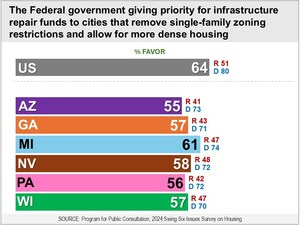COLLEGE PARK, Md., April 20, 2022 /PRNewswire/ -- Based on an in-depth survey, 61% of voters favor using ranked choice voting in general federal elections, including 73% of Democrats and 55% of independents. Republicans are divided, 49% in favor and 50% opposed. The survey of 1,296 voters was conducted by University of Maryland's Program for Public Consultation.
Ranked choice voting, a method proposed for federal elections in the Fair Representation Act (H.R. 3863), seeks to make it more possible for independent and third party candidates to compete in elections. More than 50 jurisdictions have used or plan to use ranked choice voting in their elections, including New York City. Maine and Alaska have decided to use it in federal elections.
"American voters are frustrated with the partisan polarization in American democracy but are often afraid of voting for independent or third party candidates because they do not want to effectively throw away their vote," commented PPC Director, Steven Kull. "Ranked choice voting is appealing as a way to solve this conundrum."
In ranked choice voting, when there are more than two candidates, voters select their first choice and rank candidates by preference. If none of the candidates get a majority, the candidate with the lowest number of votes is eliminated. Voters who favored the eliminated
candidate have their votes switched to their second choice. The tally is then recalculated and the candidate with a majority of votes is the winner. If there are more than three candidates, the process is repeated until there is one candidate with a majority of votes counted.
To ensure that respondents understood the issue, they were briefed on the proposal and evaluated the prevailing arguments for and against. Both arguments for and against were found convincing by majorities, but the arguments in favor were found convincing by larger majorities.
PPC analyzed the partisan orientation of respondents' Congressional districts using Cook's PVI ratings. Majorities in all types of districts favored ranked choice voting in congressional elections from very red 56% to very blue 63%.
The survey was conducted online from July 13- Sept. 15, 2021 with a national probability-based sample provided by Nielsen's sample of respondents, recruited by mail and telephone. Margin of Error: +/- 2.7%.
CONTACT: JP Thomas
[email protected]
617.899.8570
SOURCE Program for Public Consultation

WANT YOUR COMPANY'S NEWS FEATURED ON PRNEWSWIRE.COM?
Newsrooms &
Influencers
Digital Media
Outlets
Journalists
Opted In





Share this article